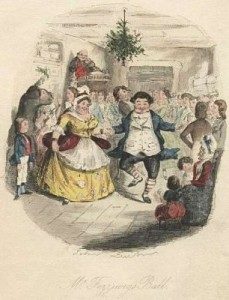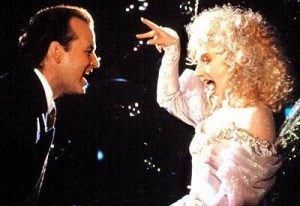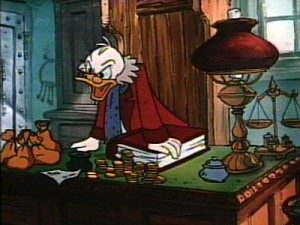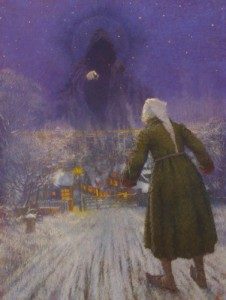
An original illustration from A Christmas Carol
Ebenezer Scrooge, the miser of all misers, the progenitor of the inimitable phrase “Bah Humbug”, and the hallmark of the so-called power of the Christmas Spirit -that spirit of course being the objective sense of community and generosity one is supposed to feel once they’ve been visited by their very own Diskens’-esque trio of misfit ghosts, who in turn bring tidings of what was, what is and ultimately what will be.
A Christmas Carol is perhaps the most famous tale in the whole of classic literature, along side Hamlet and maybe The Tell Tale Heart. Dickens’ work has been twisted and torn and morphed and adapted for every manner of presentation. It’s been cartoon-ized, modernized and simplified, but in the end the story remains largely the same. It’s a morality tale, but is the moral really what TV networks and cartoon production companies push at us almost nightly from December 1st right up until the celebrated arrival of old Saint Nick?
It has always struck me, the propensity for people to ignore the harder truths of such stories, in favour of those more easily digested. It is a convenient thing to see that Scrooge took heed from his wispy callers, and quickly changed his own outlook on the nature and value of Christmas, that he ultimately opened his eyes to all that was wrong with his life and his person as a result of this harrowing experience. Isn’t it telling though, that a man should need the outside influence of the supernatural in order to see the error of his ways?
Scrooge though was a larger than life character, as is to be expected from such prose, so we should excuse the lengths to which Dickens went to teach his protagonist a lesson. I think though, that Dickens was hiding a deeper moral truth in this work, hiding it right under our noses.
Despite this, what follows is an editorial critique of the story, from the perspective of a fictional ghost hunter (me).
 Setting aside that we know conclusively that this story is entirely fictional; can we set up some pseudo-facts to examine, in an effort to determine if our beloved Scrooge did indeed experience the company of four ghosts on that fateful night?
Setting aside that we know conclusively that this story is entirely fictional; can we set up some pseudo-facts to examine, in an effort to determine if our beloved Scrooge did indeed experience the company of four ghosts on that fateful night?
The first encounter our unwitting hero experiences is a timely reunion with a dearly departed friend. Moreover, Scrooge is faced with the gruesome and frightening apparition of his old partner and mentor Jacob Marley; who, in the various incarnations of the story, appears to Scrooge in clanking chains and rotted flesh -apparently a punishment for his own miserly ways in life. His coming to Scrooge is a warning that Ebenezer himself is lined up for a similar fate, and to punctuate that warning Marley has arranged for three spirits, ghosts of particular ability and affiliation, to visit him on this eve, and so explain to him the virtues of embracing the Christmas Spirit, as though a late conversion is better than none at all.
In the original story, as opposed to the any one of its modern perversions, Marley appears to Scrooge shortly after he retires for the night following a particularly stressful day. The encounter is anything but typical of a ghostly experience. It ends up being an interactive apparition with ectoplasmic form and clairaudience. Shall we say…rare?
Much like the other spirits, Marley speaks directly to Scrooge, though in this case, Scrooge rightly suspects that these ethereal visions are the result of a partly digested bit of bad pork.

Bill Murray and Carol Kane (Ghost of Christmas Present) in Scrooged(1988)
Next up of course, is the first of the three Ghosts of Christmas, in this his first lesson, Scrooge is transported into the past, so that he may observe and reflect on his various misdeeds and poor choices. The highlight of this segment is the warming of Scrooges heart to the idea that he did once love and indeed can love again. It is this transportation through time that lends credence to the experience for Scrooge; he heard the Spirit’s words, he felt its touch and its presence, and for that matter he had heard and felt that same essence with Marley, but this time he believed.
Secondly, and only after finding himself safely, warmly back in his own bed, Scrooge is visited by the Ghost of Christmas Present (a nice play on words, which I’m sure wasn’t intended by Dickens, but rather is relevant only to modern readers in a time of incensed materialism). This time his guest fly’s him out the bedchamber window and proceeds to show him the harm his attitudes have done to the people of his life who are in need. People Scrooge saw daily, whom he interacted with and whose lives he knew virtually nothing about. Ebenezer was right to feel ashamed, to be abashed by the effect his behaviour has had on those less fortunate. The highlight of this episode is the life and home of Ebenezer’s employee, Bob Crachit and his hobbled son Tiny Tim. It would not have been adequate for Scrooge to simply experience and identify with the hardships of poverty and then to see that in spite of this hardship Crachit bears him no ill will; no, the handicap of Tiny Tim was the catalyst for change in this act, apparently to suggest that mere paucity is too mundane for the Spirit of Christmas to handle. Or was it that Scrooge was extra deserving of a lesson or two in the face of all that was wrong with the Cratchit household?
Once again Scrooge found himself safe and warm in his bedchamber at the close of this second encounter, though to his own admission he needed no further encouragement from the spirits to change his ways, and drastically. He had seen what was and what is, and had decided like any other that he would do more to help those in need –though more, in Scrooge’s case, was tantamount to raising Bob Crachit’s salary and allowing him to care for himself and his family (and in my mind would have been a better outcome).

Disney’s Scrooge McDuck
However, on his third and final encounter, Scrooge found himself in the company of a menacing and intimidating spirit -the Ghost of Christmas Future. Given images and ideas of isolation and solitude, of dying alone and unappreciated, of bearing no legacy on the world, other than to perpetuate the overly thrifty survival of his Counting House, or as in the original, the untimely and unfortunate death of the crippled Tiny Tim; this it seems was too much for Ebenezer Scrooge. He begged and pleaded with the spirit to allow him a chance to change things, he was motivated now, to off-load his immense wealth through charitable donations, and to seek the value of people rather than of things and money.
Aside from examination of the ghostly elements of this story, I feel compelled to point out that the plot would have worked out much the same, had the story taken place over another holiday, say Labour Day, or even over a regular Tuesday in the middle of summer. The moral herein is no more exclusive to Christmas than is the idea of kissing under the mistletoe –which is connected to Christmas only because Holly flowers in December.
Now, considering all that we know about Ebenezer’s campfire ghost story, the most obvious conclusion is that he experienced a night terror that was connected to sleep paralysis. Each encounter took place as an interruption to his nights sleep, and the indication that he had been preoccupied by distaste for Christmas prior to retiring suggests that the issue weighted heavily on his dreams as well. This would have been a frightening experience for sure, but not fundamentally supernatural.
The physical elements of each encounter are not entirely foreign to night terror experiences, often Experiencers claim that their dreams are so vibrant and convincing that they cannot believe they were simply dreams. One argument could be made for the seemingly accurate details Scrooge gleaned of Crachit’s home and life, details we are to believe he didn’t have prior to this experience. For explanatory purposes, we can present two possibilities, each with their own merits though one may seem more plausible than the other.

Ebenezer and the Ghost of Christmas Future
Over the years, working closely with Crachit in the Counting Office, Scrooge no doubt heard countless details of Crachit’s life, and though he may consciously have avoided acknowledging these details, his subconscious mind would have stored the information and in turn it would have shaped his view of Crachit and what Crachit meant to the community. This subconscious accounting of Crachit’s life would have been ample for constructing a sufficiently accurate mental picture of what the Crachit family would have been experiencing during the Christmas holiday.
Alternatively, it could be said that old Scrooge had a bit of the vision in him. That he was psychic, at least partially. I admit this is a stretch, and as I said earlier, one of these possibilities holds more water than the other.
All in all, the facts of the story don’t seem to support the idea that Ebenezer’s new acquaintances were ghosts. No one but Ebenezer saw or experienced them; in fact during the events, Ebenezer came into contact with people in his life, but none of them saw or experienced him either, suggesting that the events took place in his head. The fantastic physical feats performed by the spirits and visited on Scrooge also suggest a dream, flying, teleportation, transmutation; all of these elements are common to dreamscape. We know that the story is fiction, Ebenezer Scrooge did not exist, and neither did Jacob Marley, Bob Crachit or Tiny Tim, but there is a drastic difference I would like to point out, between believing that Scrooge had been visited by Ghosts in this fairy-tale, and in believing that he dreamed his own conversion to charity and humanitarianism.
If we accept that the Ghosts of Christmas Past, Present and Future were to be thought of as real elements of Scrooge’s world, then we inherently believe that our attitudes and beliefs are guided by an outside force, that we must depend on others to show us the ways charity, others with a higher moral authority. Alternately, if we believe that Scrooge dreamed these events, does this not suggest that he, like us, was ultimately in control of his attitudes and actions and it was his own moral compass that spoke to him while he slept, forcing him to acknowledge that he had been a miser of the worst kind, and ultimately allowed him to change for the sake of goodness on its own?
Whatever you take from this examination, or even from the classic tale of A Christmas Carol, there are lessons to be learned by each of the characters, and as I personally have no love of Dickens’ collected works, I do believe that his more popular stories should be found on the bookshelves of anyone claiming to be well read and learned.
A Christmas Carol was written by English author Charles Dickens, its original or full title is: A Christmas Carol. In Prose. Being A Ghost Story of Christmas . The book was first published December 19, 1843 with illustrations by John Leech, and is one of very few classical tales that has never been out of print since its first edition.
